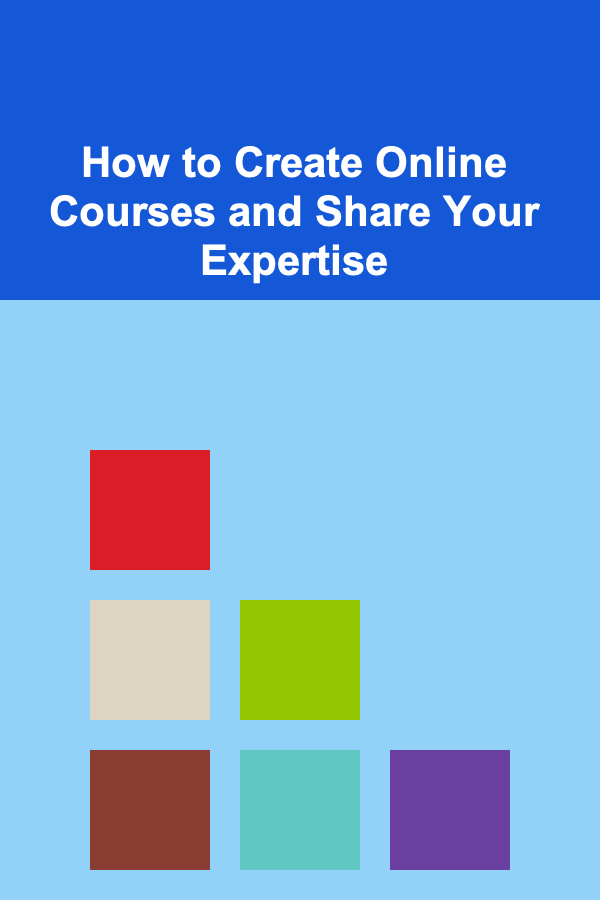
How to Create Online Courses and Share Your Expertise
ebook include PDF & Audio bundle (Micro Guide)
$12.99$8.99
Limited Time Offer! Order within the next:

The rise of digital education has revolutionized how people learn, paving the way for experts from various fields to share their knowledge with a global audience. Whether you're a seasoned professional in a specific industry, an academic, or someone with a passion for teaching, creating an online course can be a powerful way to share your expertise and earn an income. But how exactly do you create an online course that is engaging, valuable, and impactful? This comprehensive guide will walk you through the steps to create an online course that stands out in the crowded marketplace of digital learning.
Understand the Market and Identify Your Niche
1.1 Research Your Target Audience
Before you start planning your course, it's essential to understand who your target audience is. Are they beginners or advanced learners in your subject? What specific problems or pain points do they need help with? What are their learning preferences, such as video-based, text-based, or interactive learning?
Conduct market research to gain insights into these questions. Engage with potential learners through surveys, social media, or forums to understand their needs and interests. This research will help you tailor your course content and approach to meet the expectations of your audience.
1.2 Find Your Niche
The online learning market is vast, with numerous courses available on a wide range of topics. To stand out, you need to carve out a niche for your course. Specializing in a specific area of expertise will allow you to offer targeted content that addresses the unique needs of a particular group of learners.
For example, rather than creating a broad course on "Digital Marketing," you might choose to focus on a specific aspect of digital marketing, such as "SEO for Small Businesses" or "Instagram Marketing for Influencers." This narrow focus will help you appeal to a more defined audience, allowing you to build a reputation as a specialist in that area.
Plan Your Course Content
2.1 Define Your Learning Objectives
A successful online course is one that provides value and helps learners achieve specific goals. Start by defining clear and measurable learning objectives for your course. What do you want your students to be able to do after completing your course? These objectives should be specific, actionable, and aligned with your target audience's needs.
For example:
- By the end of this course, learners will be able to build a basic website using WordPress.
- After completing the course, students will have the skills to run a paid social media ad campaign.
Defining your learning objectives upfront will guide your content creation and ensure that every module of your course contributes to the overall learning experience.
2.2 Break Down the Content into Modules
Once you have your learning objectives in place, it's time to break down your course into smaller, manageable modules or sections. Organize the content in a logical sequence that builds upon previous lessons, ensuring a smooth flow of information.
Each module should focus on a specific topic or skill and be structured around your learning objectives. For example, in a course about "Social Media Marketing," the modules might look like this:
- Module 1: Introduction to Social Media Marketing
- Module 2: Understanding Your Target Audience
- Module 3: Creating Engaging Content
- Module 4: Running Paid Ads on Social Media
- Module 5: Measuring Social Media Success
2.3 Choose the Course Format
Your course format will significantly impact how learners engage with the content. There are several formats to choose from, depending on your subject matter and your audience's preferences:
- Video-Based Courses: The most popular format for online courses. Video allows you to demonstrate concepts, provide explanations, and engage with students visually.
- Text-Based Courses: Some learners prefer to read content rather than watch videos. Text-based courses can be in the form of articles, guides, or eBooks.
- Interactive Courses: These may include quizzes, assignments, and practical exercises that allow students to apply what they've learned.
- Hybrid Courses: A combination of video, text, and interactive elements to cater to different learning styles.
Decide which format or combination of formats will be most effective in helping your learners achieve their objectives.
Create Engaging Course Material
3.1 Script Your Videos
If you're creating a video-based course, scripting your videos beforehand is crucial. A script helps ensure that you cover all the necessary information without rambling or missing important details. Keep your scripts concise, clear, and focused on the topic at hand. Use simple language and break down complex concepts into digestible chunks.
For example, in a course on digital photography, your script might include step-by-step instructions on how to adjust the exposure settings on a camera. Visual aids like diagrams or screenshots can further help clarify your points.
3.2 Record and Edit Your Videos
When it comes to recording, ensure that your videos are of high quality. Invest in a good camera and microphone to ensure clear visuals and sound. Lighting is also crucial---natural light or softbox lights can enhance video quality and make you look professional.
While you're recording, be mindful of the pacing of your delivery. Avoid speaking too quickly, and allow time for students to absorb information. Keep your videos engaging by using a friendly tone and encouraging interaction.
Once you have your raw footage, use video editing software to polish your videos. Cut out any unnecessary parts, add text overlays for key points, and insert transitions or effects to maintain visual interest.
3.3 Create Additional Learning Resources
In addition to your core video lessons, consider creating supplementary materials that can enhance the learning experience. These might include:
- Workbooks or PDFs: These can serve as summaries or guides for learners to reference while studying.
- Quizzes and Assignments: These help reinforce learning and allow students to test their knowledge.
- Discussion Forums: Setting up a space for students to discuss lessons and ask questions can foster a sense of community and increase engagement.
3.4 Optimize for Different Devices
Online learners access courses from a variety of devices, including smartphones, tablets, and desktop computers. Ensure that your course is mobile-friendly and looks great across all devices. Choose a course platform that provides responsive design, or test your course on different devices to make sure everything functions properly.
Choose a Platform to Host Your Course
4.1 Self-Hosting vs. Course Platforms
There are two primary ways to host your online course: self-hosting or using an online course platform. Both have their pros and cons.
- Self-Hosting: If you choose to host the course on your own website, you have full control over the design, pricing, and marketing. You'll need to set up an e-commerce system, integrate payment processors, and handle hosting yourself. Popular tools for this approach include WordPress with plugins like LearnDash or Teachable.
- Course Platforms: Using platforms like Udemy, Teachable, or Skillshare is an easier and more streamlined option for many course creators. These platforms handle hosting, payment processing, and marketing for you, allowing you to focus on content creation. However, they may take a commission on sales and offer less control over pricing and branding.
Choosing the right platform depends on your technical skills, resources, and the level of control you want over your course.
Market Your Online Course
Creating an amazing course is just the first step. To generate revenue and attract students, you need a solid marketing strategy. Here are some effective marketing tactics:
5.1 Build an Email List
One of the best ways to market your course is through email. Start building an email list by offering valuable free content, such as a free eBook, webinar, or mini-course. Use this list to nurture relationships with potential students and notify them when your course is live.
5.2 Leverage Social Media
Social media platforms like Instagram, Facebook, and LinkedIn are great tools for reaching your target audience. Share content related to your course, engage with followers, and provide sneak peeks of your course material to generate interest. Consider running paid ads to target specific demographics who would benefit from your course.
5.3 Use Affiliate Marketing
Affiliate marketing can be a great way to expand your reach. Partner with influencers or bloggers who can promote your course to their audience in exchange for a commission on sales. This can help you tap into established communities and increase course sales.
5.4 Offer Discounts and Promotions
Attract early adopters by offering discounts or running promotions. You might offer a limited-time discount, bundle your course with additional resources, or provide access to a private community for those who purchase early.
5.5 Utilize Testimonials and Reviews
Social proof is powerful. Encourage students to leave reviews and testimonials, which you can use to market your course to new potential learners. Positive feedback can reassure prospective students that your course is worth their time and money.
Engage with Your Students and Keep Improving
Once your course is live, the learning doesn't stop. Engage with your students regularly by answering questions, offering support, and providing additional resources. Monitor feedback and use it to improve your course over time.
Consider updating your course regularly with new content, industry trends, or advanced lessons to keep it relevant and valuable. Additionally, you can create follow-up courses or offer coaching services to provide ongoing support for your learners.
Conclusion
Creating an online course is a rewarding way to share your expertise with a global audience. By carefully planning your course content, choosing the right platform, and employing effective marketing strategies, you can turn your knowledge into a profitable online business. The key to success lies in providing value to your learners, engaging them throughout the course, and continuously improving based on their feedback. So, if you have valuable knowledge to share, start planning your online course today and take the first step toward becoming a successful online educator.
Other Products

How to Choose the Right Shopify Plan for Your Dropshipping Business
Read More
How to Create a Backyard Camping Experience for the Family
Read More
How to Maintain Your Water Heater for Optimal Performance
Read More
How to Manage Multiple Streams of Income Without Overwhelming Yourself
Read More
How to Store Office Supplies Without Cluttering Your Desk
Read More